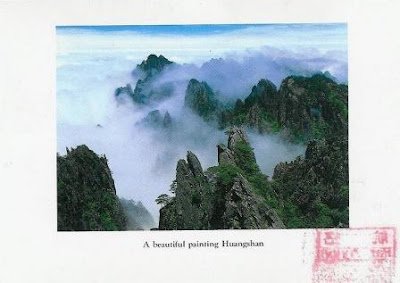Mt. Huangshan in China is also a UNESCO site, it was inscribed in 1990. Since 2008 I've got all these cards from there and they were sent by Lucy, Qusia, Carol, Abay and Lior.
Mount Huangshan, often described as the “loveliest mountain of China”, has played an important role in the history of art and literature in China since the Tang Dynasty around the 8th century, when a legend dated from the year 747 described the mountain as the place of discovery of the long-sought elixir of immortality.
This legend gave Mount Huangshan its name and assured its place in Chinese history. Mount Huangshan became a magnet for hermits, poets and landscape artists, fascinated by its dramatic mountainous landscape consisting of numerous granitic peaks, many over 1,000 m high, emerging through a perpetual sea of clouds. During the Ming Dynasty from around the 16th century, this landscape and its numerous grotesquely-shaped rocks and ancient, gnarled trees inspired the influential Shanshui (“Mountain and Water”) school of landscape painting, providing a fundamental representation of the oriental landscape in the world’s imagination and art.
CN-1715633, sent by Carol.
The property, located in the humid subtropical monsoon climate zone of China’s Anhui Province and covering an area of 15,400 ha with a buffer zone of 14,200 ha, is also of outstanding importance for its botanical richness and for the conservation of a number of locally or nationally endemic plant species, some of which are threatened with extinction. - in: http://whc.unesco.org/en/list/547
CN-881756, sent by Abay.
Celestial Capital Peak, also known as Tiandu Peak, with 1.830 meters high, is one of the three major peaks of Mt. Huangshan.
The climb, dangerous in the old days, is a "walk-over", with stone steps placed or hewn along the trail and iron chains to cling to. Now 43,000 steps link all the peaks and a winding path 3,800 meters long has been paved for the convenience of tourists. The peak is over 5900, is one of the steepest and most breathtaking peaks of Mount Huang. At the top of the peak is a stone carving of 4 Chinese characters "Deng Feng Zao Ji" (the highest peak), as the peak surpasses the others in the surrounding area.
A traveler in old times that failed to reach the top sighed as he composed this poem:
“How I wish I could ride a crane some day to view the sea of clouds over Tiandu Peak.”
The top of the peak is flat with a natural cave large enough to hold more than one hundred people. The saying goes: “Without reaching Jade Screen Pavilion, a panoramic view of the mountain is impossible; without climbing Tiandu Peak, your trip is in vain”." - in: http://www.china-tour.cn/Huangshan/Tiandu-Peak.htm










1 comment:
Hi Martinha! I like looking at your blog and your cool postcards. I'm a postcrosser too, and have a blog to show off my cards. Would you mind if I put your blog in my listing of blogs?
You can find me at http://littleepistles.blogspot.jp if you'd like to check it out first!
Post a Comment